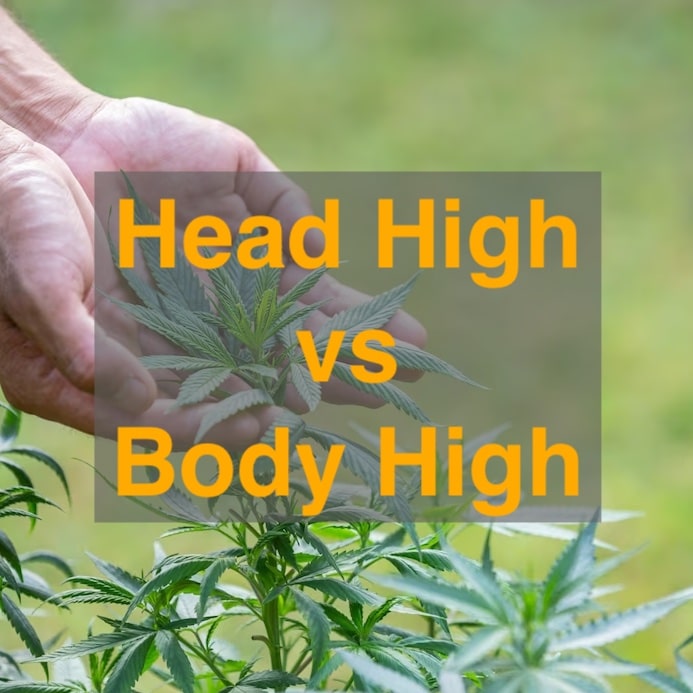In the world of cannabis, the effects of different strains can vary significantly, leading to diverse experiences for users. Among the most common distinctions are the “head high” and “body high.” These terms refer to the unique sensations and effects produced by various cannabis strains. Understanding the differences between a head high and a body high can empower enthusiasts to select the perfect strain to suit their desired experiences. In this article, we will delve into the characteristics of head and body highs, explore the types of strains that elicit them, and uncover the nuances that make each one unique.
Table of Contents
Understanding Cannabis: Sativa, Indica, and Hybrid
Before jumping into the heart of the subject we need to have a bit of context about Cannabis strains. In the realm of cannabis, the two primary types are Sativa and Indica, each offering distinct effects.
- Sativa plants grow tall and has light green, thin leaves. Sativa strains are known to induce “head high” effects which includes, energizing and uplifting effects, often enhancing creativity and focus, making them ideal for daytime use.
- Indica plants are shorter, bushier with broader leaves. They are known to provide a more relaxing and sedative experience (often compared as “head high”), often preferred for nighttime use to help with relaxation and sleep.
- Hybrids combine traits from both Sativa and Indica, offering a balanced effect that can be tailored to address specific needs or preferences, making them versatile for various users.
Most of the strains available today are hybrids. This shift reflects a growing desire for personalized cannabis experiences, combining the distinct effects, flavours, yield, smell etc… the idea is to offer a wide spectrum of unique flowers. Usually when you go buy your flowers, you will get a Dominance as well as the balance between Sativa and Indica.
The Mechanism Behind Cannabis-Induced Highs
THC, or tetrahydrocannabinol, is a chemical compound in the cannabis plant known for its psychoactive properties, which produces the “high” sensation. It is found in the resin, also know as trichomes secreted by the cannabis plant, particularly concentrated in the flowers, or buds. THC interacts with the body’s endocannabinoid system by binding to cannabinoid receptors, primarily in the brain, affecting mood, perception, and other cognitive functions.
What is a head high?
Benefits
A head high is a psychoactive effect of cannabis that primarily cerebral, leading to feeling happy, creative, energetic, and uplifted. Sativa strains are known to create a head high. For example you might feel inspired to engage in artsy activities or motivated for physical activities.
Iconic Sativa strains like Sour Diesel, Green Crack, and Jack Herer are known for their energizing and uplifting effects, ideal for stimulating both the mind and body. This cerebral high can induce a sense of mental clarity and introspection, making it a popular choice during day time or for social gatherings.
Side Effects
The drawback of a head high, particularly from strains with high THC content, can include heightened anxiety or paranoia in some users. This adverse reaction is due to THC’s psychoactive properties, which, while enhancing creativity and sensory perception, can also amplify stress or predispose to overthinking in susceptible individuals. Additionally, inexperienced users or those with a low tolerance may find the intense mental stimulation overwhelming, leading to discomfort or a negative experience.
What is Body High?
A body high is a type of high that affects the physical body rather than the mind. It produced by Indica or Indica dominant hybrid strains. Unlike a head high, which influences cognitive and sensory perceptions, a body high focuses on physical sensations. Body highs are particularly appreciated for their therapeutic benefits, especially for physical ailments and sleep disorders. However, the intensity of these effects can vary based on the specific strain, the user’s tolerance, and the consumption method.
Benefits
- Relaxation Users often experience deep relaxation and a sense of calm throughout the body.
- Pain Relief It can significantly reduce pain, making it beneficial for those with chronic pain conditions.
- Muscle Relaxation There’s a notable easing of muscle tension, beneficial for relaxation or therapeutic purposes.
- Sleep Improvement Many users find it easier to fall and stay asleep, making it ideal for those with insomnia.
Side Effects
- Drowsiness: A common side effect is feeling sleepy or lethargic, which might not be ideal for daytime use.
- Reduced Motor Skills: There can be a temporary decrease in coordination and motor skills, affecting activities that require focus and precision.
- Increased Appetite: Often referred to as “the munchies,” it can lead to an increased appetite.
What are the different types of highs?
|
Head High |
Body High | |
Benefits |
|
|
Effects |
|
|
Strains |
|
|
Conclusion
In conclusion, understanding the difference between a head high and a body high is crucial for cannabis consumers to make informed choices about the strains they use. A head high primarily affects the mind, producing euphoria, mental stimulation, and altered perception, making it suitable for creative endeavors and social activities. On the other hand, a body high targets physical sensations, inducing relaxation, pain relief, and potential sedation, making it ideal for relaxation and nighttime use.
Each type of high offers unique benefits and experiences, and individuals may prefer one over the other based on their preferences and intended use. As with any cannabis consumption, responsible use and awareness of strain potency are essential for a safe and enjoyable experience. By understanding the distinctions between these highs, users can better select strains that align with their desired effects and enhance their overall cannabis journey.

